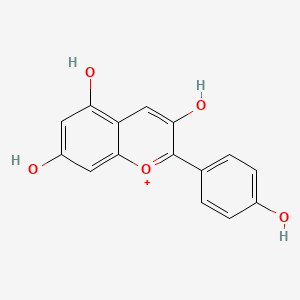| MeSH term | MeSH ID | Detail |
|---|---|---|
| Cystitis | D003556 | 23 associated lipids |
| Parkinsonian Disorders | D020734 | 20 associated lipids |
Pelargonidin
Pelargonidin is a lipid of Polyketides (PK) class. The involved functions are known as Uptake, Intestinal Absorption, glucose uptake, Process and Metabolic Inhibition. Pelargonidin often locates in Serosal, Mucous Membrane, brush border membrane, Membrane and Cell surface. The associated genes with Pelargonidin are SLC5A1 gene, SLC2A2 gene, Homologous Gene, F3 gene and CRSP3 gene. The related experimental models are Knock-out.
Cross Reference
Introduction
To understand associated biological information of Pelargonidin, we collected biological information of abnormalities, associated pathways, cellular/molecular locations, biological functions, related genes/proteins, lipids and common seen animal/experimental models with organized paragraphs from literatures.
What diseases are associated with Pelargonidin?
There are no associated biomedical information in the current reference collection.
Possible diseases from mapped MeSH terms on references
We collected disease MeSH terms mapped to the references associated with Pelargonidin
PubChem Associated disorders and diseases
What pathways are associated with Pelargonidin
There are no associated biomedical information in the current reference collection.
PubChem Biomolecular Interactions and Pathways
Link to PubChem Biomolecular Interactions and PathwaysWhat cellular locations are associated with Pelargonidin?
Visualization in cellular structure
Associated locations are in red color. Not associated locations are in black.
Related references are published most in these journals:
| Location | Cross reference | Weighted score | Related literatures |
|---|
What functions are associated with Pelargonidin?
Related references are published most in these journals:
| Function | Cross reference | Weighted score | Related literatures |
|---|
What lipids are associated with Pelargonidin?
There are no associated biomedical information in the current reference collection.
What genes are associated with Pelargonidin?
Related references are published most in these journals:
| Gene | Cross reference | Weighted score | Related literatures |
|---|
What common seen animal models are associated with Pelargonidin?
Knock-out
Knock-out are used in the study 'MATE2 mediates vacuolar sequestration of flavonoid glycosides and glycoside malonates in Medicago truncatula.' (Zhao J et al., 2011).
Related references are published most in these journals:
| Model | Cross reference | Weighted score | Related literatures |
|---|
NCBI Entrez Crosslinks
All references with Pelargonidin
Download all related citations| Authors | Title | Published | Journal | PubMed Link |
|---|---|---|---|---|
| Giusti MM et al. | Molar absorptivity and color characteristics of acylated and non-acylated pelargonidin-based anthocyanins. | 1999 | J. Agric. Food Chem. | pmid:10552862 |
| Saito N et al. | Acylated pelargonidin 3-sambubioside-5-glucosides in Matthiola incana. | 1996 | Phytochemistry | pmid:8722092 |
| Elomaa P et al. | Transgene inactivation in Petunia hybrida is influenced by the properties of the foreign gene. | 1995 | Mol. Gen. Genet. | pmid:7476867 |
| Akhmadieva AKh et al. | [The protective action of a natural preparation of anthocyan (pelargonidin-3,5-diglucoside)]. | 1993 May-Jun | Radiobiologiia | pmid:8332723 |
| Cherian S and Augusti KT | Antidiabetic effects of a glycoside of leucopelargonidin isolated from Ficus bengalensis Linn. | 1993 | Indian J. Exp. Biol. | pmid:8500813 |
| Lu TS et al. | Acylated pelargonidin glycosides in the red-purple flowers of Pharbitis nil. | 1992 | Phytochemistry | pmid:1367882 |
| Cherian S et al. | Antidiabetic effect of a glycoside of pelargonidin isolated from the bark of Ficus bengalensis Linn. | 1992 | Indian J. Biochem. Biophys. | pmid:1427968 |
| Marinov BS and Ruzieva RKh | [Opposite control of O2 affinity for hemoglobin by donors and acceptors]. | 1990 | Biokhimiia | pmid:2078638 |
| Linn F et al. | Epigenetic changes in the expression of the maize A1 gene in Petunia hybrida: role of numbers of integrated gene copies and state of methylation. | 1990 | Mol. Gen. Genet. | pmid:1703268 |
| Fang J | Classification of fruits based on anthocyanin types and relevance to their health effects. | Nutrition | pmid:26250485 | |
| Gargouri M et al. | The epimerase activity of anthocyanidin reductase from Vitis vinifera and its regiospecific hydride transfers. | Biol. Chem. | pmid:20030585 | |
| Hanlon PR and Barnes DM | Phytochemical composition and biological activity of 8 varieties of radish (Raphanus sativus L.) sprouts and mature taproots. | J. Food Sci. | pmid:21535648 | |
| Wolniak M and Wawer I | (13)C CPMAS NMR and DFT calculations of anthocyanidins. | Solid State Nucl Magn Reson | pmid:18657953 | |
| pmid: | ||||
| Afaq F et al. | Pomegranate fruit extract modulates UV-B-mediated phosphorylation of mitogen-activated protein kinases and activation of nuclear factor kappa B in normal human epidermal keratinocytes paragraph sign. | Photochem. Photobiol. | pmid:15493960 | |
| Cambie RC and Ferguson LR | Potential functional foods in the traditional Maori diet. | Mutat. Res. | pmid:12628508 |
